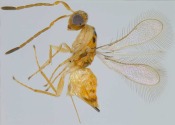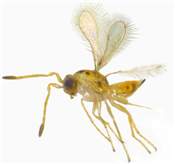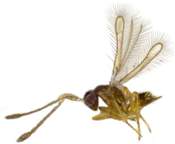 Fig 1. Adult, lateral view |
 Fig 2. Adult, lateral view |
 Fig 3. Adult, lateral view |
 Fig 4. Female, lateral view |
_sml.jpg) Fig 5. Antenna |
 Fig 6. Antenna |
_sml.jpg) Fig 7. Wings |
 Fig 8. Forewing |
Ramesh Kumar et al., 2013
Nomenclature
Arescon Walker, 1846: 50. Type species: Mymar dimidiatus Curtis, by monotypy.
Leimacis Forster, 1847: 208. Type species: Leimacis rufula Forster, by monotypy. Synonymy; by Forster 1856: 119).
Xenomymar Crawford, 1913: 349. Type species: Xenomymar urichi Crawford, by original designation. Synonymy by Annecke and Doutt (1961: 12).
Neurotes Enock, 1914: cxxxiv. Type species: Neurotes iridescens Enock, by monotypy. Synonymy by De Santis (1967: 102).
Diagnosis
Arescon belongs to the Arescon group of genera and the diagnostic characters are as follows:
- Female head in side view more or less evenly curved anteriorly
- Ocelli enclosed by stemmaticum
- Antenna (Figs. 5, 6) with 5-segmented funicle, first segment usually shortest
- Marginal vein (Figs. 7, 8) greatly elongate, venation extending to half or more the length of wing and much longer than submarginal vein
- Tarsi 4-segmented, protibial spur not comb-like along inner margin.
Geographic Distribution
Australian, Oriental, and Neotropical regions (Lin et al., 2008). See Indian distribution map.
View Distribution map of Arescon in a larger map
Hosts and habitat
Parasitoids of Cicadellidae. Arescon enocki is known to parasitize Amrasca devastans.
Species in India
1. enocki (Subba Rao and Kaur, 1959) (original description as Neurotes enocki); Subba Rao (1966) (distribution) (Distribution: Bihar, Delhi, Gujarat, Himachal Pradesh, Karnataka and Maharashtra)
2. mudigerensis Subba Rao, 1989 (original description) (Distribution: Karnataka)
References
Subba Rao BR. 1989. On a collection of Indian Mymaridae (Chalcidoidae: Hymenoptera). Hexapoda, 1: 139-186.
Subba Rao BR, Hayat M. 1983. Key to the genera of Oriental Mymaridae, with a preliminary catalog (Hymenoptera: Chalcidoidea). Contributions of the American Entomological Institute, 20: 125-150.
Subba Rao BR, Kaur RB. 1959. Studies on Indian Mymaridae. I. Proceedings of the Indian Academy of Sciences. B49: 227-238.
Walker F. 1846. Descriptions of the Mymaridae. The Annals and Magazine of Natural History, 18: 49-54.